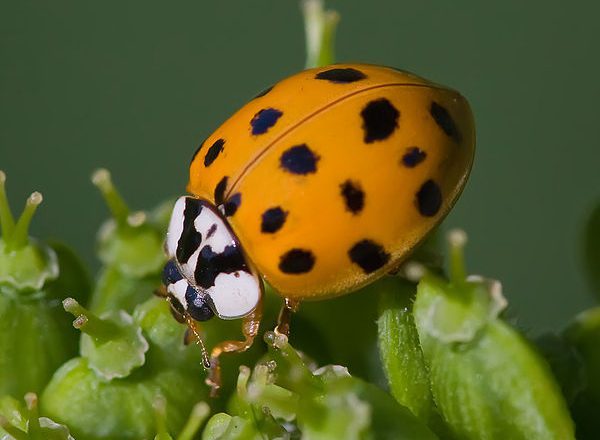She’s no lady

“Much of the damage inflicted on land is quite invisible to laymen,” noted revered conservationist Aldo Leopold. The trained ecologist, on the other hand, “lives alone in world of wounds.” She takes no pleasure in evergreen thickets of Chinese privet on a dreary winter day. She cringes at patches of lush Japanese stilt grass. She begrudges the hungry starlings even a single sunflower seed from her feeders. She is sometimes forced to retreat indoors, finding succor in her field guides, where there is purity and order. There, plants and animals are classified and categorized, their preferred habitats clearly delineated.
Learn moreThe Cornell University Department of Entomology’s Lost Ladybug Project encourages citizen scientists to search for ladybugs in their area, document the species and report findings to a central database. Read more below or click here to jump to that topic in this article. |
Alas, I also suffer these assaults on my ecological sensibilities. Even worse, as of late, our dwelling in the Uwharries hasn’t proven to be a refuge from invasive species. We’ve been plagued by Asian ladybugs (Harmonia axyridis). These otherwise charming insects – with chubby red bodies and cheery black spots – were imported to address agricultural concerns. Their voracious appetite for aphids endeared them to farmers with pecan and apple orchards. In their native range, they seem content to live in trees, so no one predicted that once they reached our shores they would feel compelled to overwinter in our houses. Like kudzu, they have gotten out of control.
Their dramatic markings might look cute to us, but they’re a defensive mechanism to ward off predators. When disturbed, they also secrete a noxious yellow fluid from their joints. Not only does this substance stain expensive household items like curtains, upholstery and carpet, the odor can trigger allergic reactions such as asthma attacks. I can tolerate the occasional ladybug in the house, but this year we’ve had them in droves – maybe it was the particularly harsh winter, or maybe I’ve tried to coexist too long. Regardless, I’ve recently launched a major offensive against the invading swarms of Asian ladybugs.
My eradication campaign is actually defensive – I’ve been mopping up the ones that hunkered down around our storm windows last fall. On warm, sunny days, when they became more active, I’d keep the vacuum cleaner handy and make an occasional sweep of the windowsills. In the dead of winter, this seemed to be sufficient. I convinced myself I was making headway. As we moved toward spring, I’d suck them up then turn my attention to another window only to look back and find a few more had emerged. At one point, I thought I was losing my mind. I understood why people once believed in the concept of spontaneous generation.
Indoor insecticides are generally ineffective since they don’t get to the source of the problem, but I couldn’t keep up since I’m not there to vacuum full-time. I finally resorted to spraying the window casements with an insecticide containing pyrethrins – a chemical derived from chrysanthemums – intended for use in kitchens and pantries. It has knocked them back a bit, but new ones are still emerging.
The best approach is to keep them from entering the house in the fall by sealing up cracks around windows, doors, pipes and fascia boards where they insinuate themselves. On an older home, this can be a challenge. Outdoor nooks and crannies can also be sprayed with long-lasting insecticides. Entomologists at the University of Kentucky College of Agriculture (click here for more information) recommend Spectracide Triazicide, Bayer Advanced Powerforce Multi-Insect Killer and Ortho Home Defense Max. Not all areas need to be treated as they tend to congregate on south and west exposures where the sun is strongest. That said, we’ve also had trouble with them on the east side of the house.
While Asian ladybugs have become more numerous and expanded their range since being introduced here several decades ago, some of our native ladybug species – such as the nine-spotted, the transverse and the two-spotted – have become quite rare. The convergent ladybug is still abundant out West, but they are now much harder to find in the eastern U.S. These and other natives resemble the Asian species with their black dots on red, pink or orange wings. They also love to eat aphids, making them just as valuable for gardeners and farmers alike.
Their decline has prompted the Cornell University Department of Entomology to launch the Lost Ladybug Project. Citizen scientists are encouraged to search for ladybugs in their area, then document the species and report the findings to a central database. Over time, this helps scientists track expanding and shrinking populations. To learn more, go to www.lostladybug.org.
Another way to get involved is to release native ladybugs in your garden. I checked with the folks at Gardener’s Supply, and they assured me they sell the convergent ladybug (Hippodamia convergens). If you consider going this route and have any doubt about the species being offered, walk away. Believe me, you don’t want to risk bringing the Asian ladybug anywhere near your house.